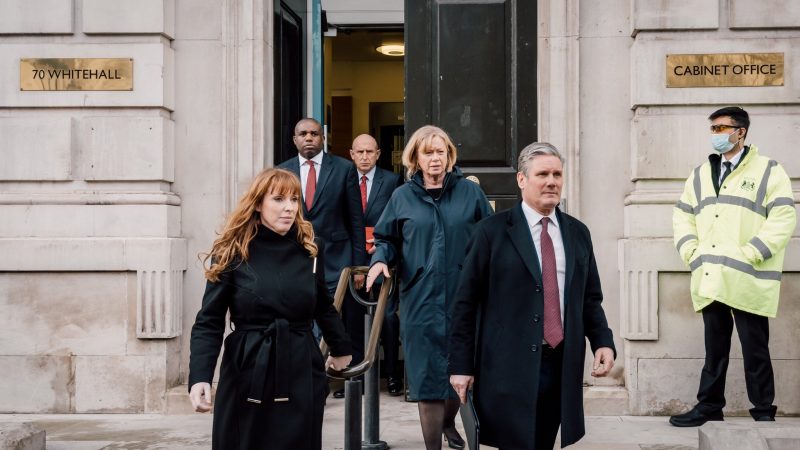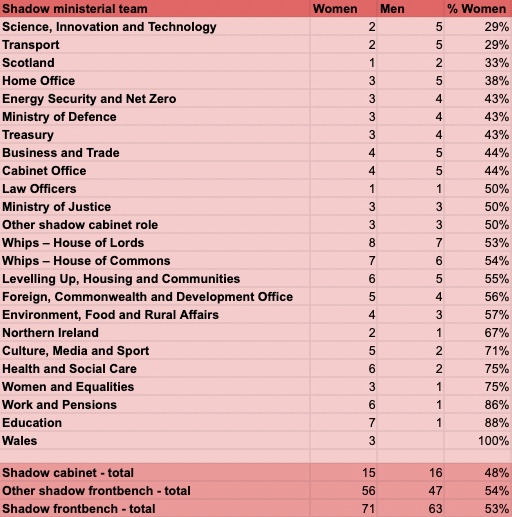
The majority of Labour’s shadow frontbench are women, LabourList analysis has revealed – but the party has been warned it still has “a lot more to do” including on equal representation across all briefs.
LabourList’s research found that 53% of those in Labour’s frontbench are women, while the shadow cabinet is very close to gender parity, with women occupying 15 out of 31 roles. It broadly reflects the gender divide among Labour MPs as a whole.
But the analysis revealed some gender gaps in who holds roles in different departmental teams, with science and transport both dominated by men, while women hold a majority of positions in health and education.
Responding to the findings, Labour Women’s Network (LWN) emphasised the need to ensure there are no more “pigeonholed” ‘men’s roles’ and ‘women’s roles’ at all levels of government, “from council chambers to the frontbench”.
Just 29% of roles in Labour’s science, innovation and technology and transport teams are held by women – though the latter team is headed up by Louise Haigh. The team with the third lowest proportion of women is the Scotland team, where women hold one of the three available roles.
By contrast, women hold all three of the roles in Labour’s Wales team. 88% of the roles in the education team are filled by women, while women occupy 86% of the positions on the work and pensions team and 75% of those in the women and equalities and health and social care teams.

Our calculated headcounts for the shadow cabinet and wider frontbench included each MP only once, but the counts for each departmental team included all shadow ministers even if they were also in other departments too.
The most recent analysis by Commons researchers found 51% of Labour MPs were women, compared to just 24% of Tory MPs. Women also held only 31% of government posts and occupied only 43% of shadow frontbench posts across opposition parties as a whole.
The research was done in 2020, however, with multiple by-elections and reshuffles since potentially significantly changing the figures.
A more recent study by LWN found 52% of Labour MPs were women. Not including sitting MPs, 45% of Labour candidates selected for the next general election are women, according to LWN.
The Fawcett Society also found in April, before the local elections, that 47% of Labour councillors were women, compared with 29% of Tory councillors. Labour is also reported to have more ethnic minority MPs than all other parties combined and have no gender pay gap among its own staff.
Shadow Women and Equalities Secretary Anneliese Dodds said: “Labour is the party of women’s rights and women’s representation.
“While there is always more to do, we are proud to be well ahead of the other parties in terms of women’s representation in parliament and on our front bench. It is concerning that other parties have not made the same progress.
“Better representation means better policy outcomes. Labour, as the party of women, brought in the Equal Pay Act, supported women’s rights to bodily autonomy and introduced SureStart.
“The next Labour government will build on that legacy, by tackling the epidemic of violence against women and girls, ending the deprioritisation of women’s health in our NHS and supporting women in the workplace with our New Deal for Working People.”
LWN director Claire Reynolds said: “Labour Women’s Network have longed pushed for women to have equal representation at all levels, and it’s great to see this parity on the front-bench as well as the PLP. This is in strong contrast to the government, with Sunak’s cabinet being a miserable 29% women.
“Labour’s success represents a long-term commitment to supporting women, through implementing positive action and investing in political programmes like the Jo Cox women in leadership scheme.
“A Labour government would see the first ever woman Chancellor and first ever woman deputy Prime Minister, with both Reeves and Rayner among the many Labour Women’s Network graduates in the House.
“To make that happen, we need women to have equal visibility in Labour’s election campaign – no more being sidelined on pink buses. With some brilliant women coming through as PPCs we look forward to replacing Tory men with Labour women.
“However, we also need to look beyond parliament to continue the good work. Currently, we’ve only one woman metro mayor, and only 25% of Labour council leaders are women, so a lot done, a lot more to do.
“From council chambers to the frontbench, we also need to make sure there are no more pigeonholed ‘men’s roles’ and ‘women’s roles’, with 50/50 representation needed across all briefs.”



More from LabourList
Local elections: ‘Key council tests for Labour in each region’
Humza Yousaf woes deepen as Labour files no-confidence vote in government
‘History and poll leads suggest Labour can be bolder, even if it costs some votes’